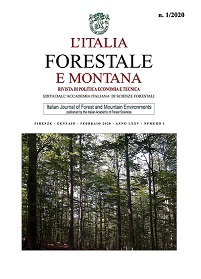Forest management and prevention of hydrogeological instability in territories of high vulnerability in Campania
Published 2020-03-02
Keywords
- sustainable coppice management,
- hydrogeological instability,
- soil conservation,
- forest planning
Copyright (c) 2020 Italian Journal of Forest and Mountain Environments

This work is licensed under a Creative Commons Attribution-NonCommercial 4.0 International License.
Abstract
This paper focuses on the compatibility between forest management and soil conservation with reference to chesnut (Castanea sativa Mill.), holm oak (Quercus ilex L.) and especially Manna Ash (Fraxinus ornus L.) mixed hop Hornbeam (Ostrya carpinifolia Scop.) coppices stands, located on slopes of Campania and characterized by intensely pedogenised pyroclastic coverage, but unstable when facing intense rainy events. Based on the Corine Land Cover system (2012), we divided the areas into the three physiognomic types; thus, the proportion of surfaces falling under the pyroclastic coverage, which are the more instable, were obtained by overlapping the land systems and soil map produced by the Campania region (2014).
For each type of coppice, we examined all the different structural conditions (traditional coppices, coppices past traditional rotation age and coppice in conversion to high forest) and underlined the most important critical issues due to clearcutting,
We summarized the different types of silvicultural interventions to improve the forest management sustainability, especially in those areas which are vulnerable to hydrogeological instability. We also stressed that forest planning is the essential tool for sustainable management of coppices, together with the catchment area and the fire-fighting planning.

